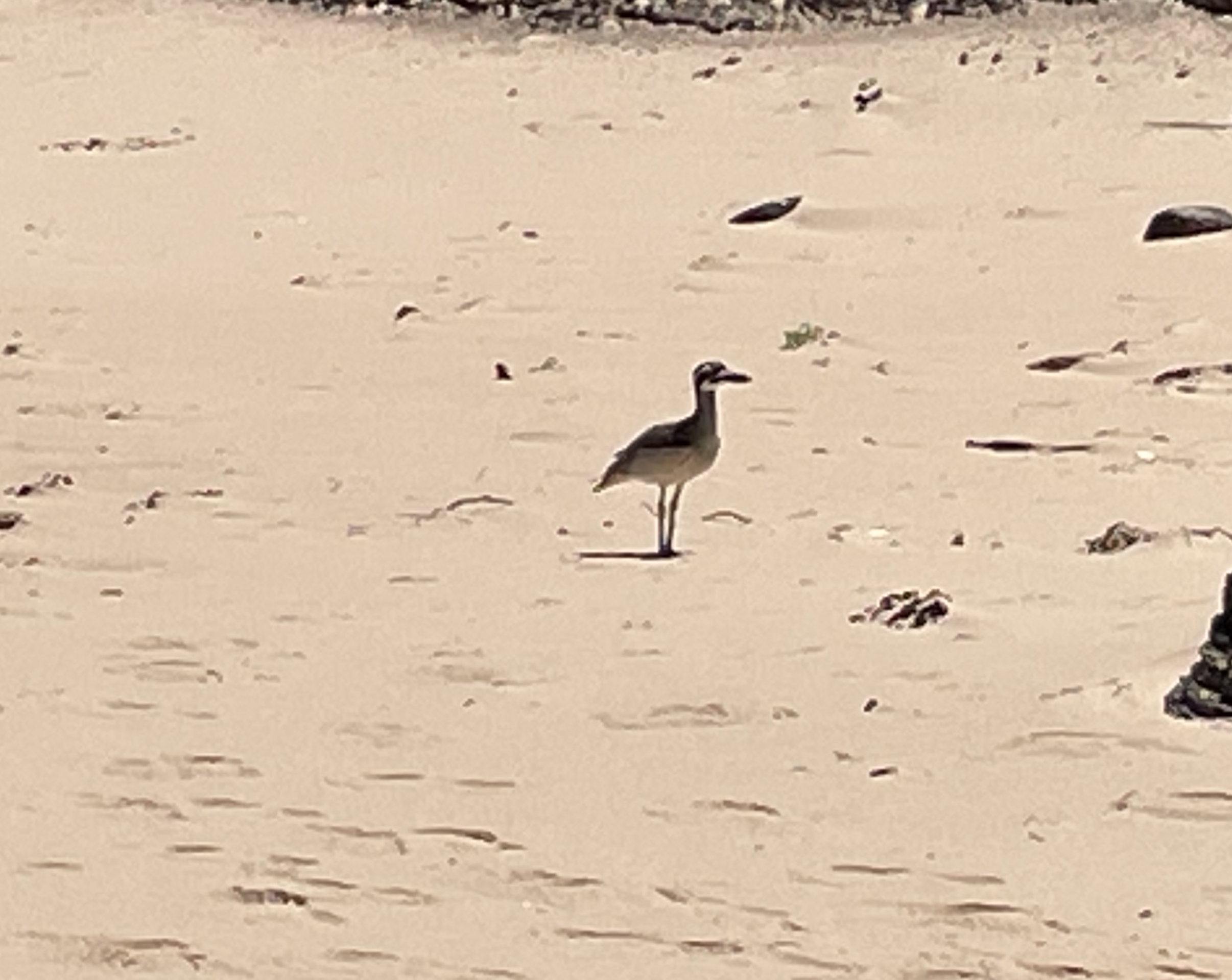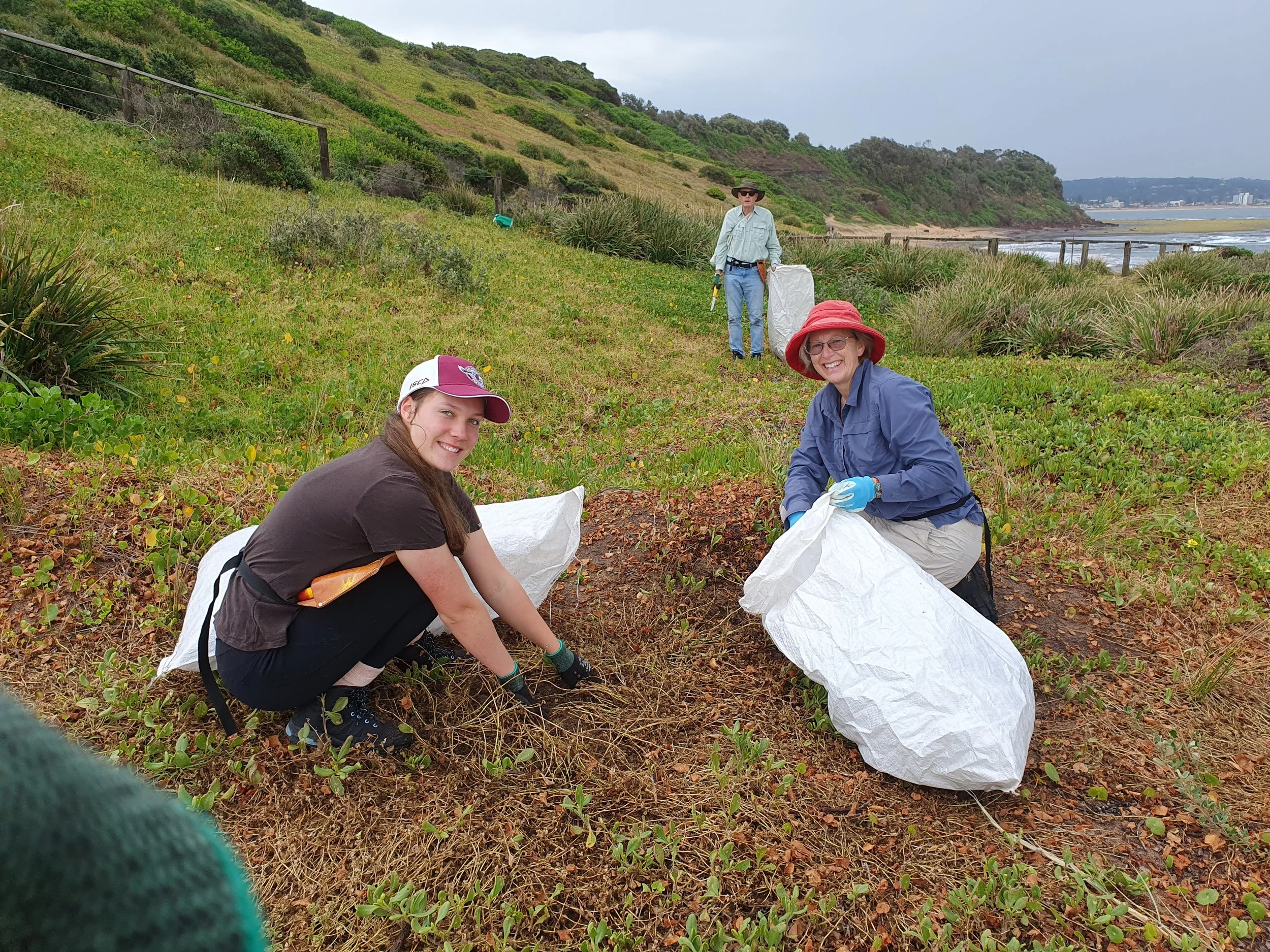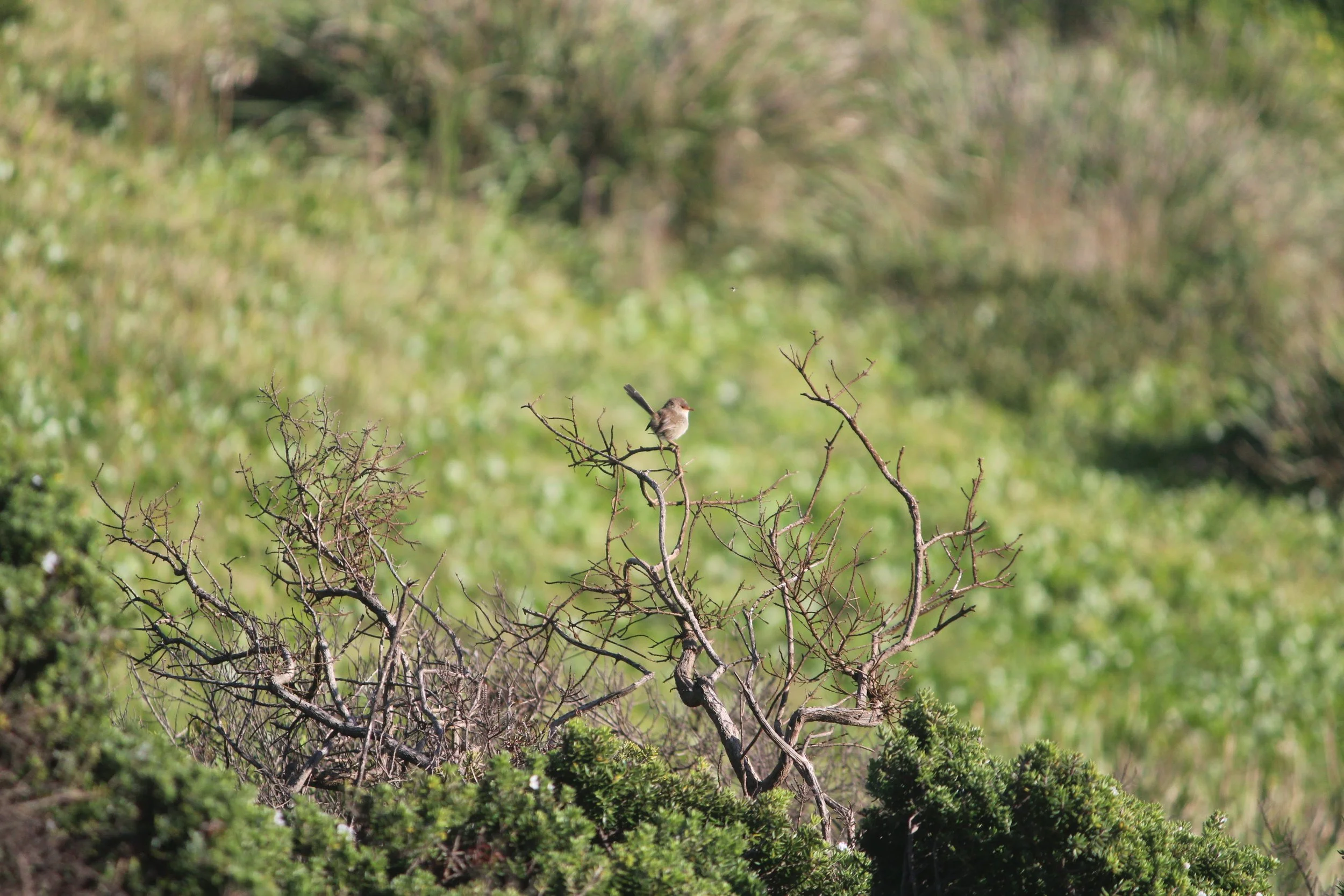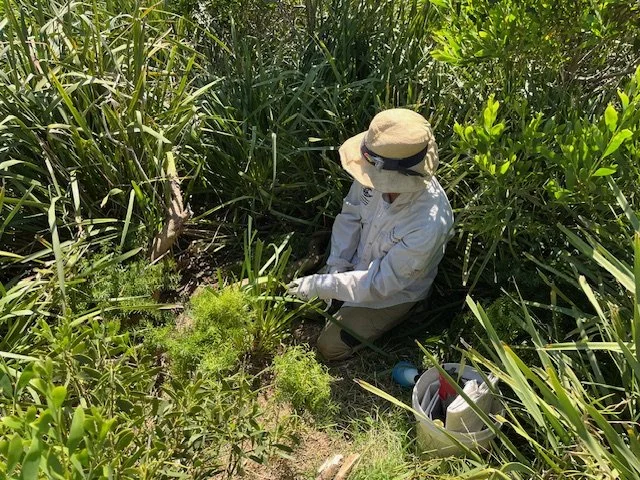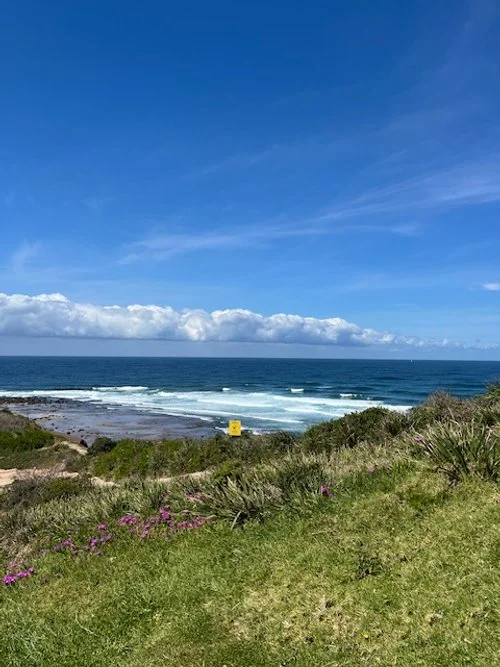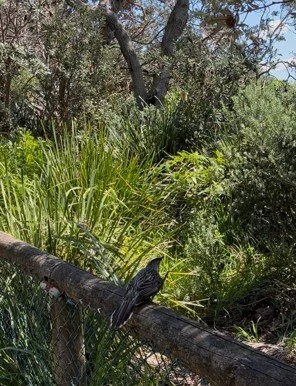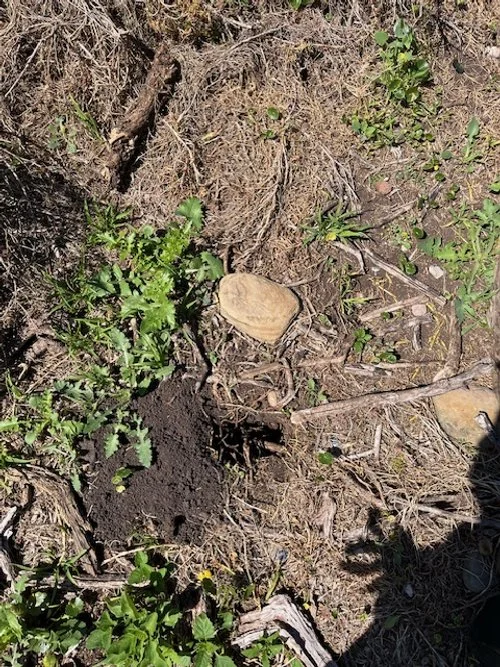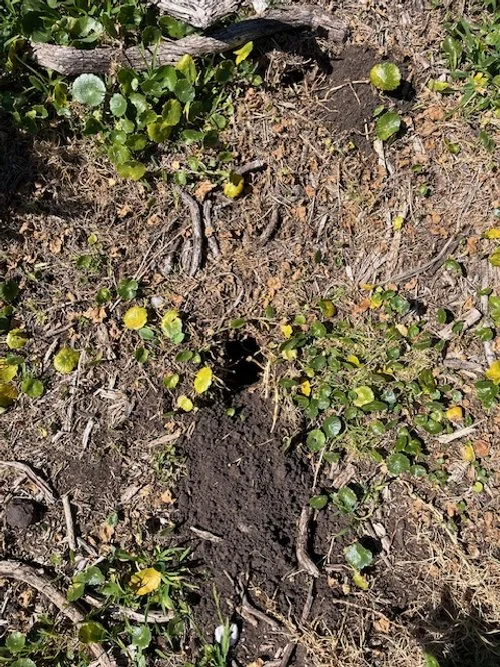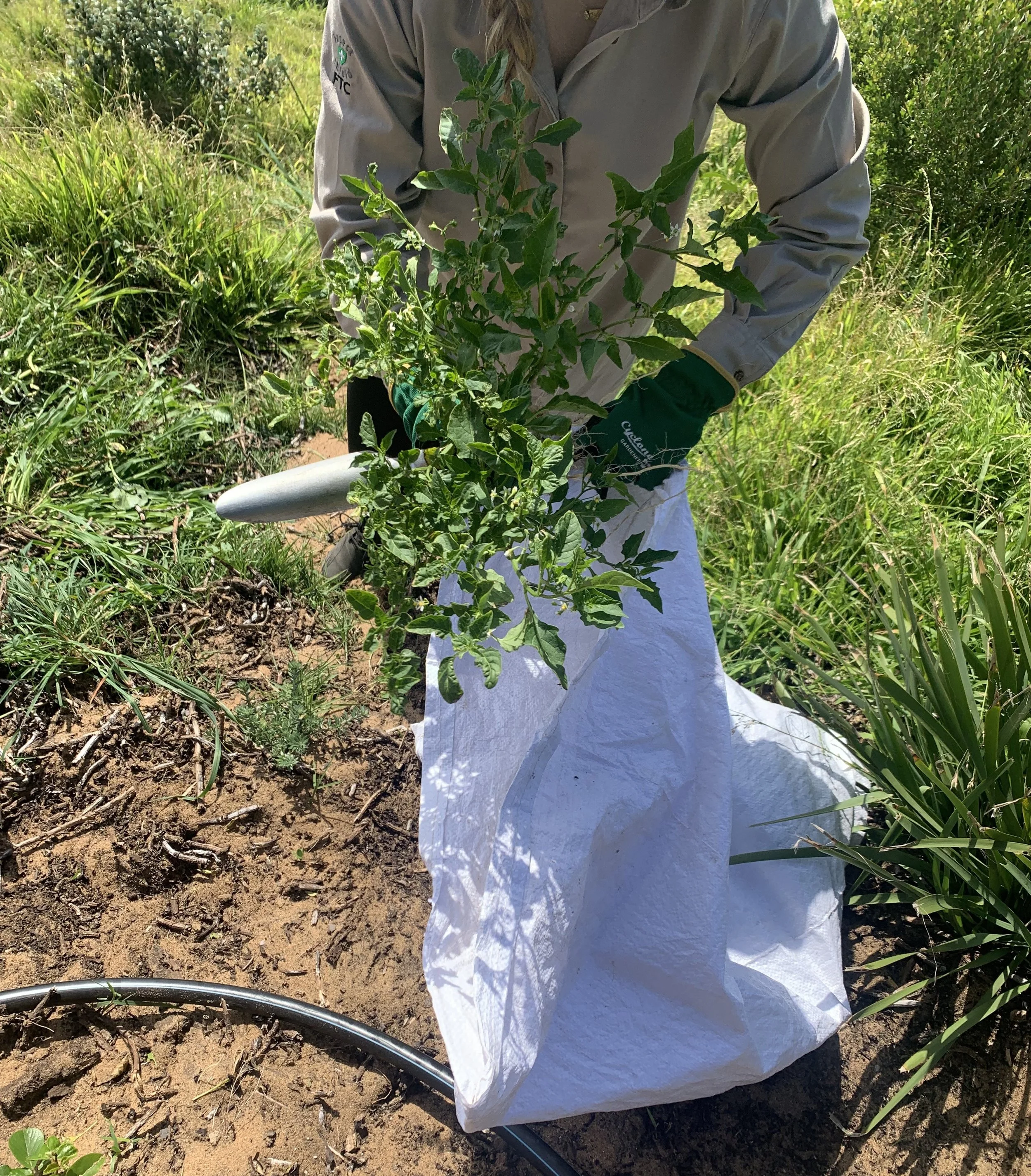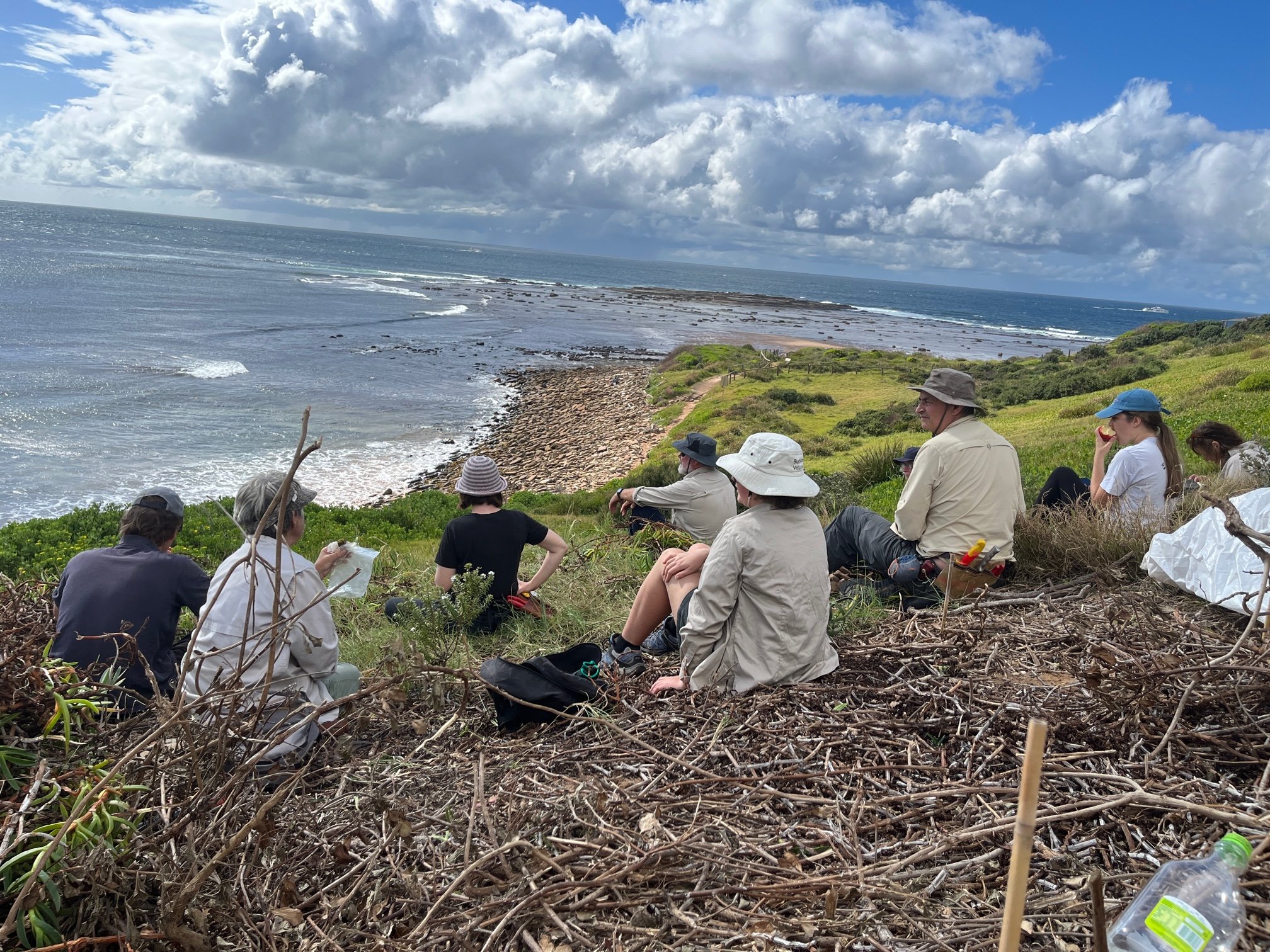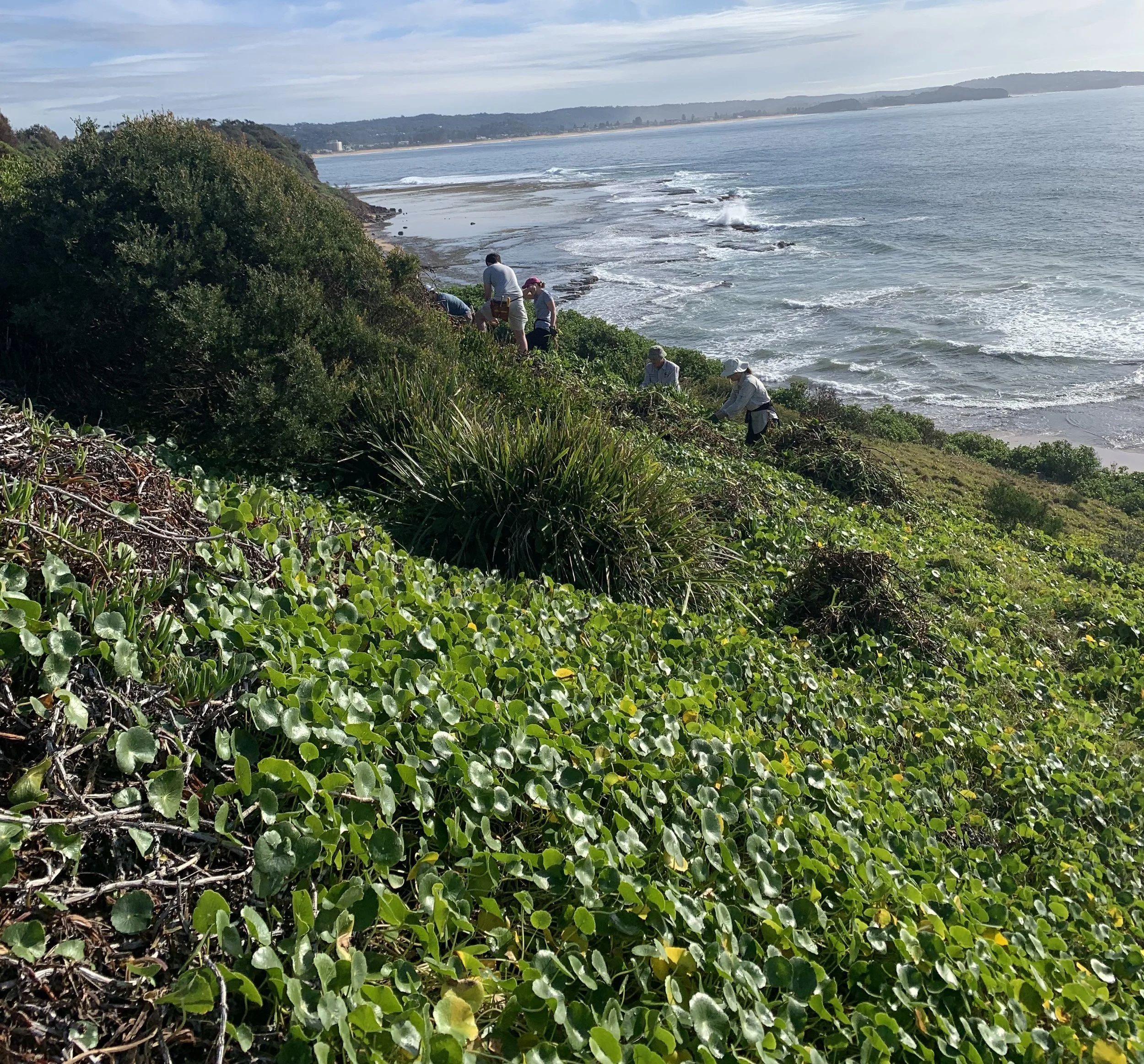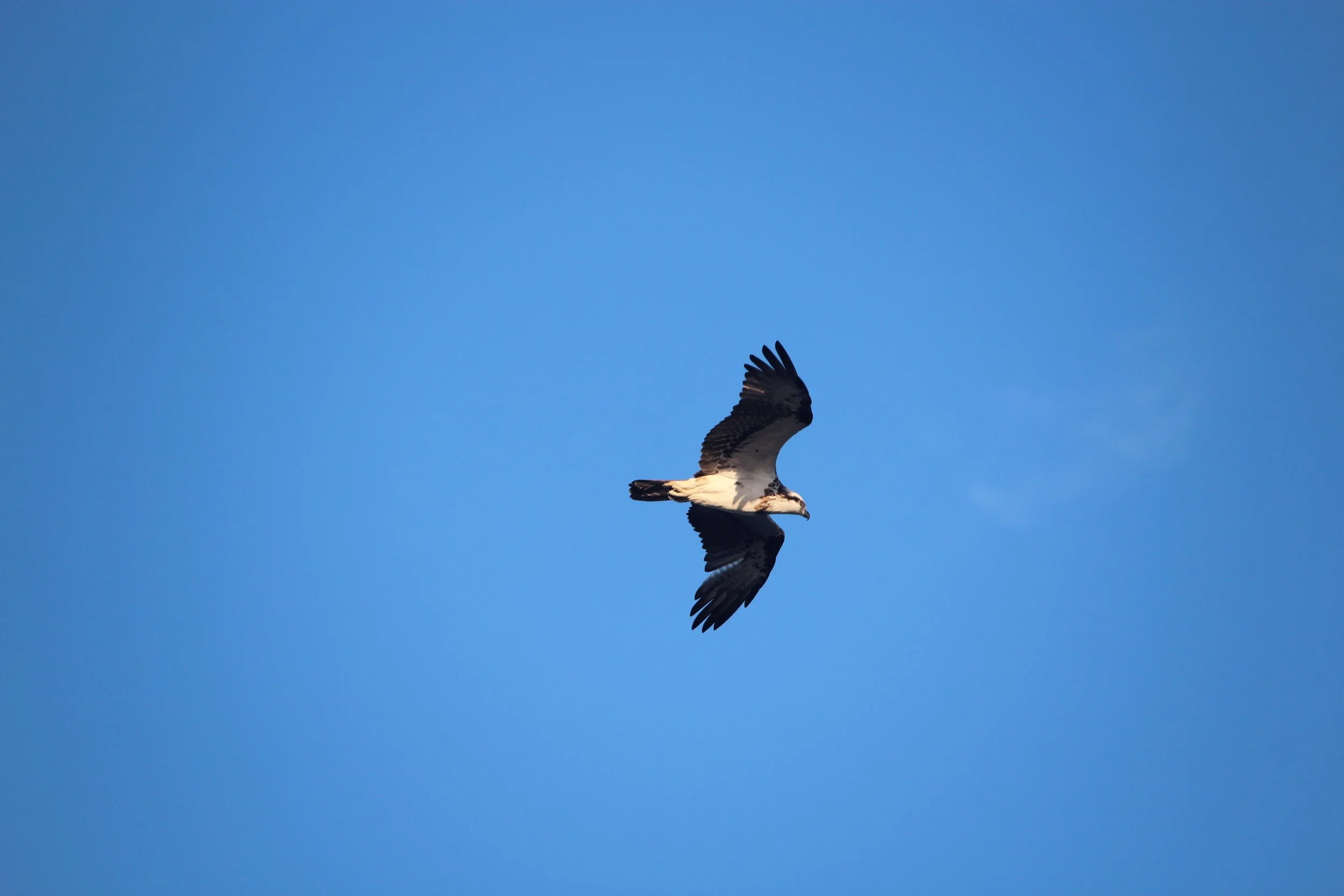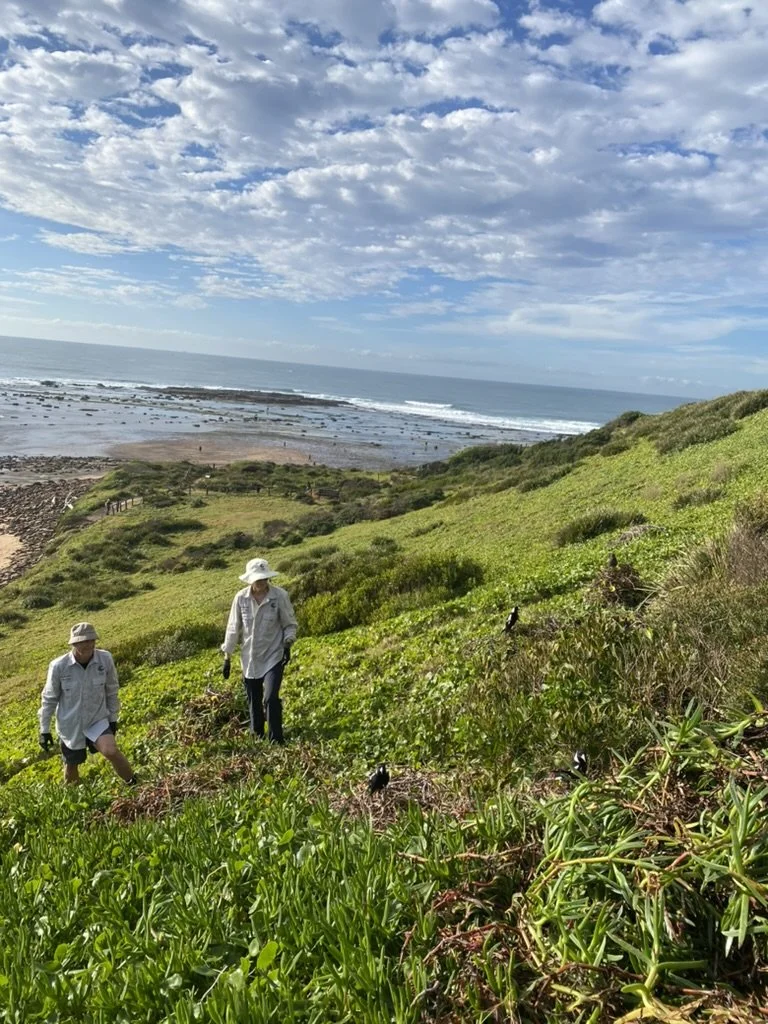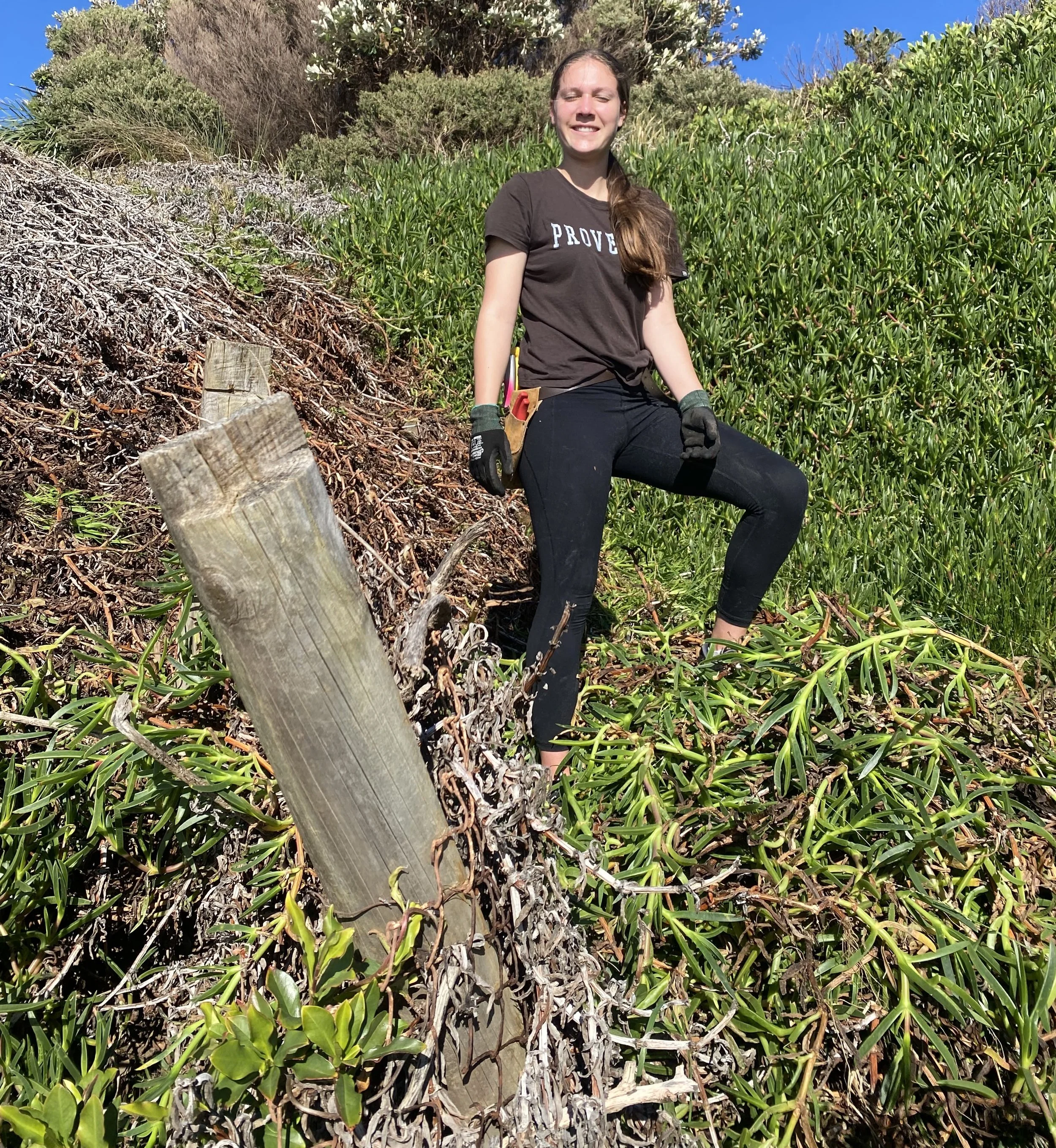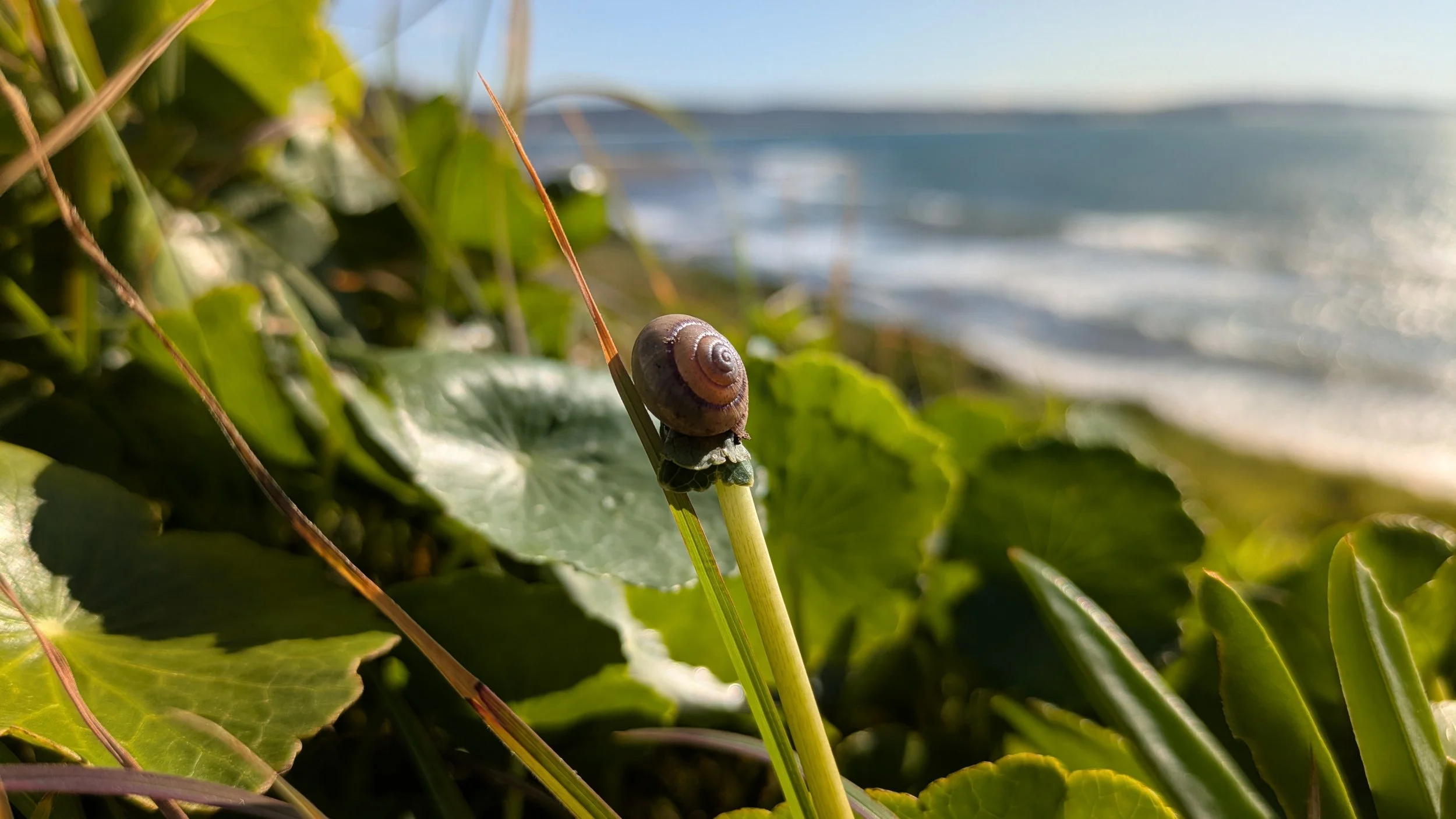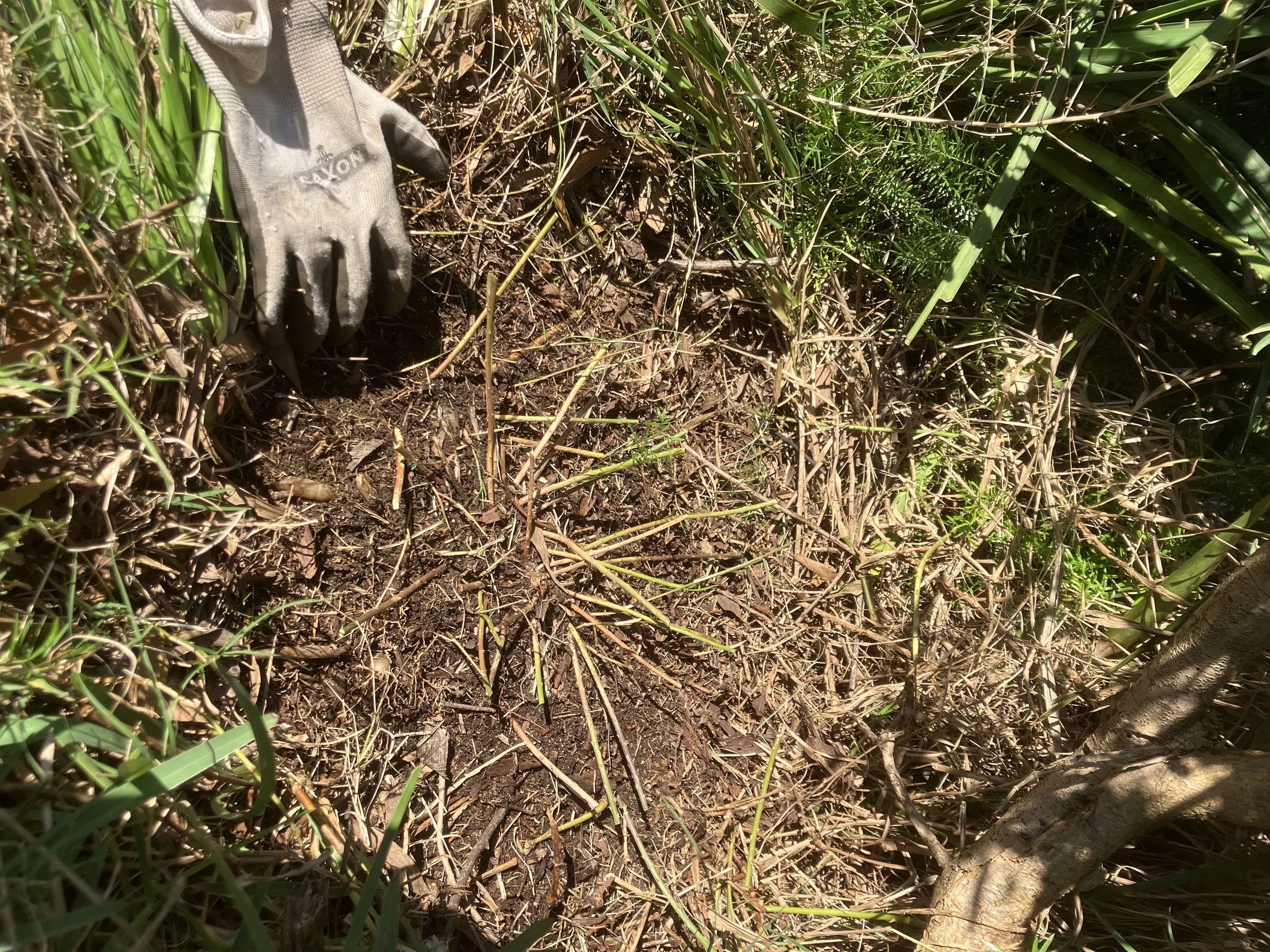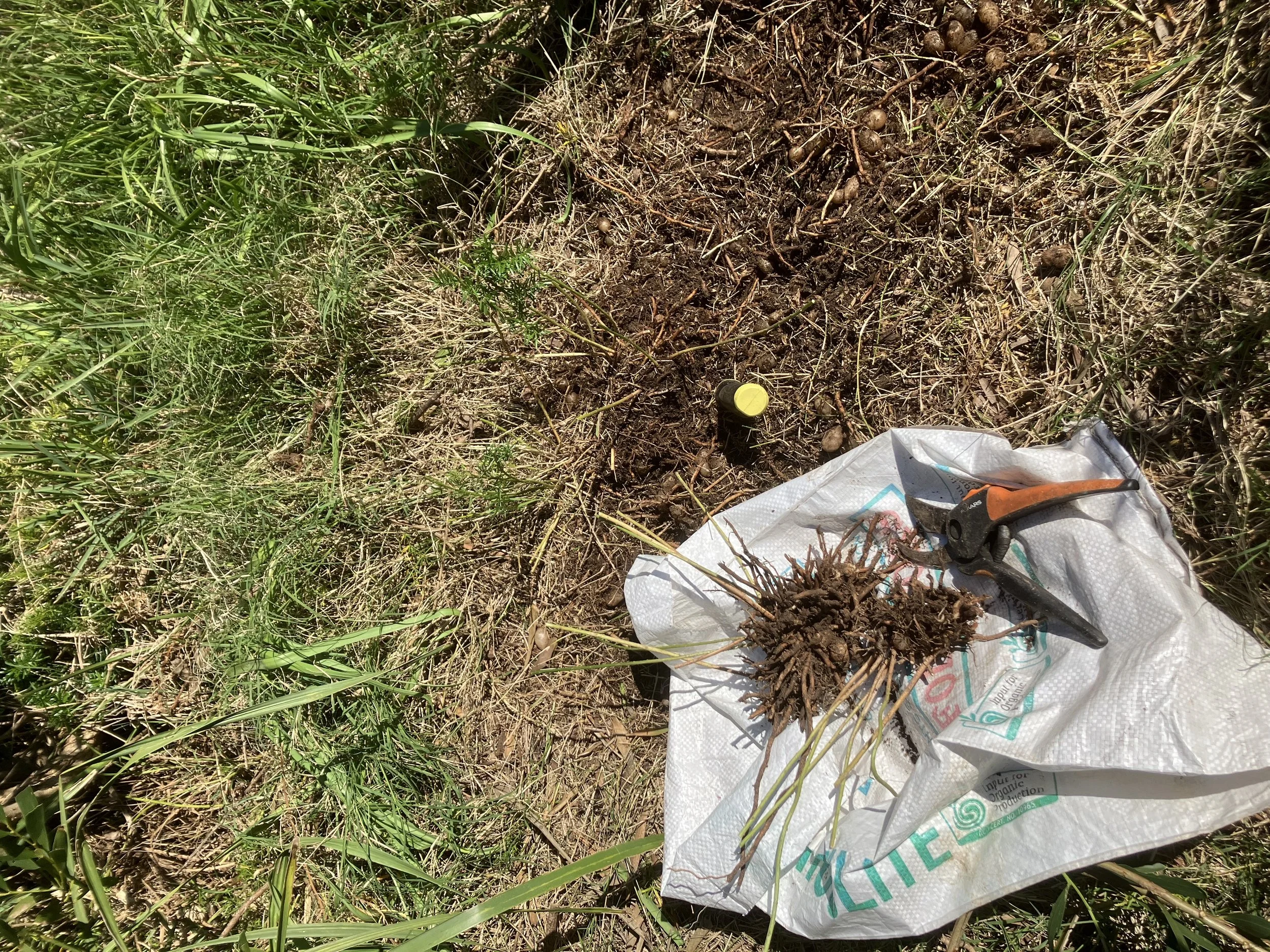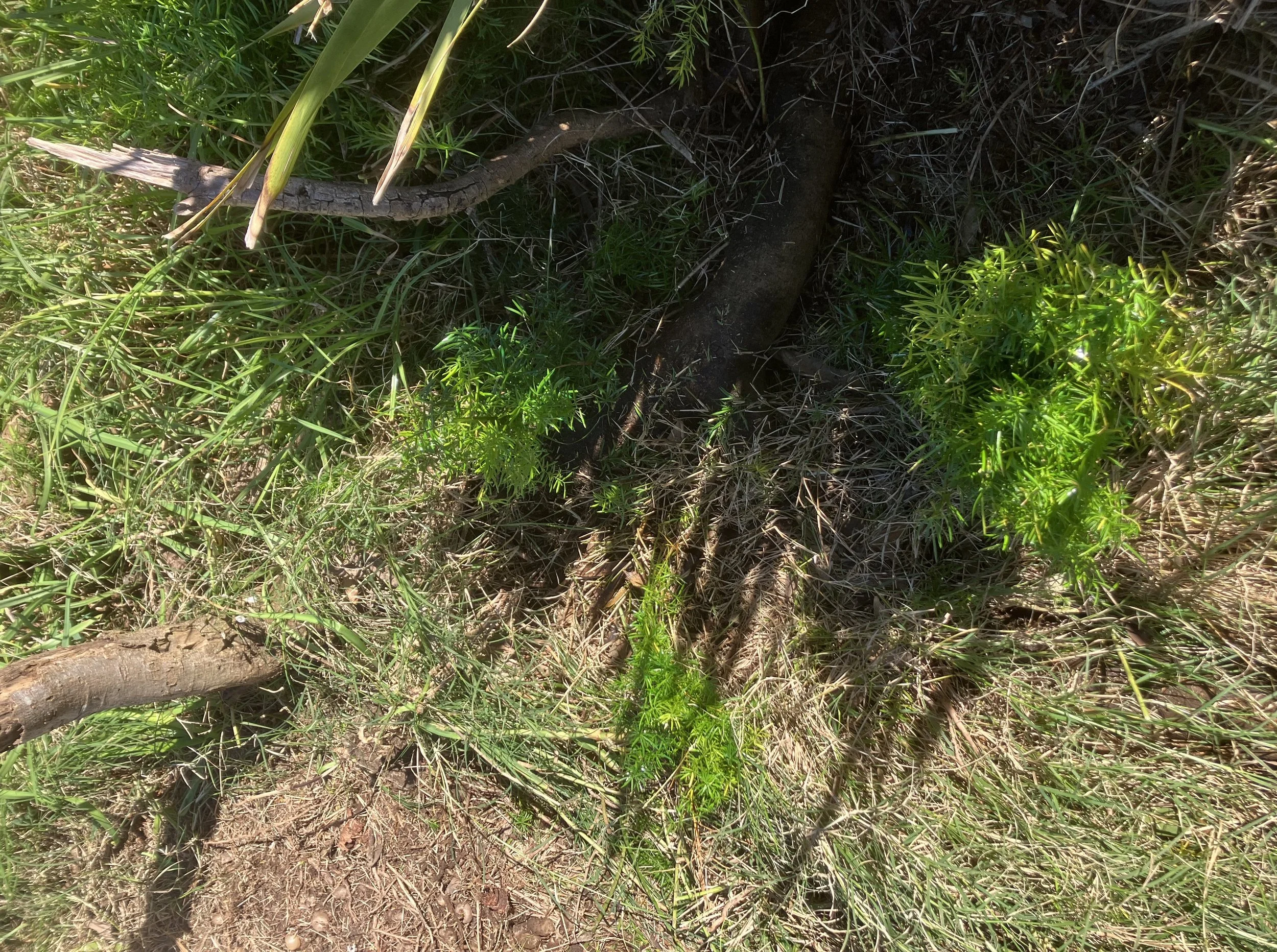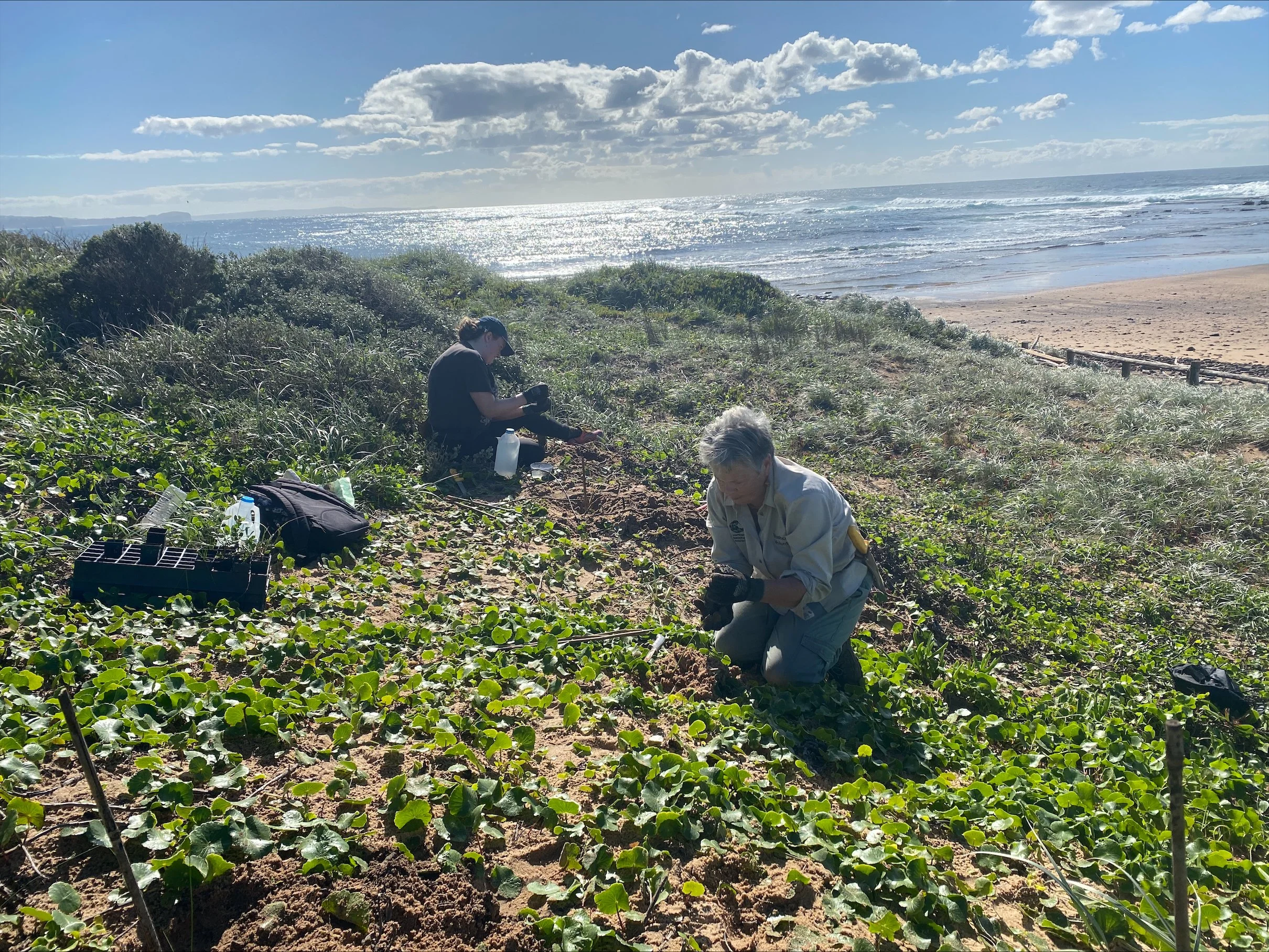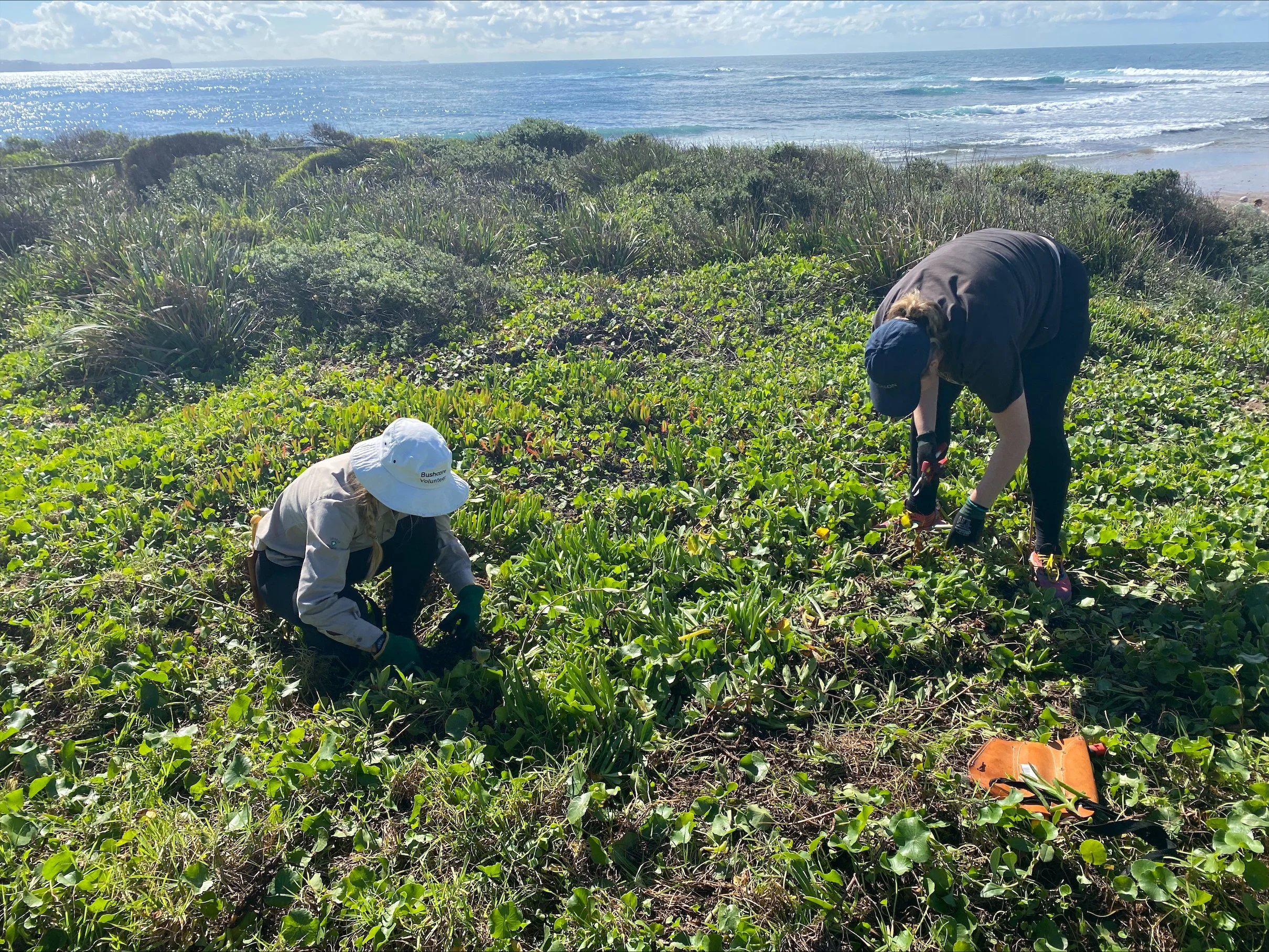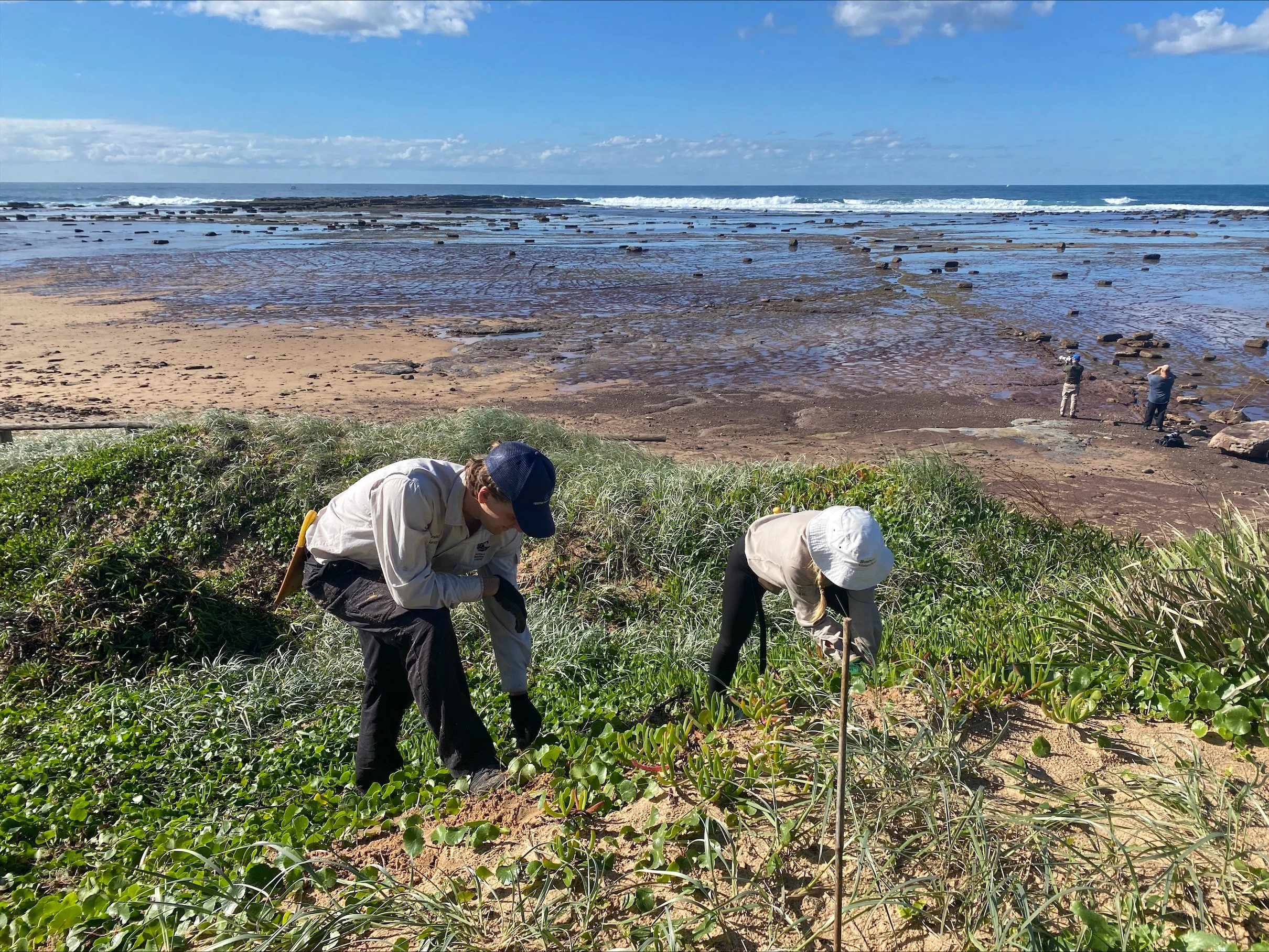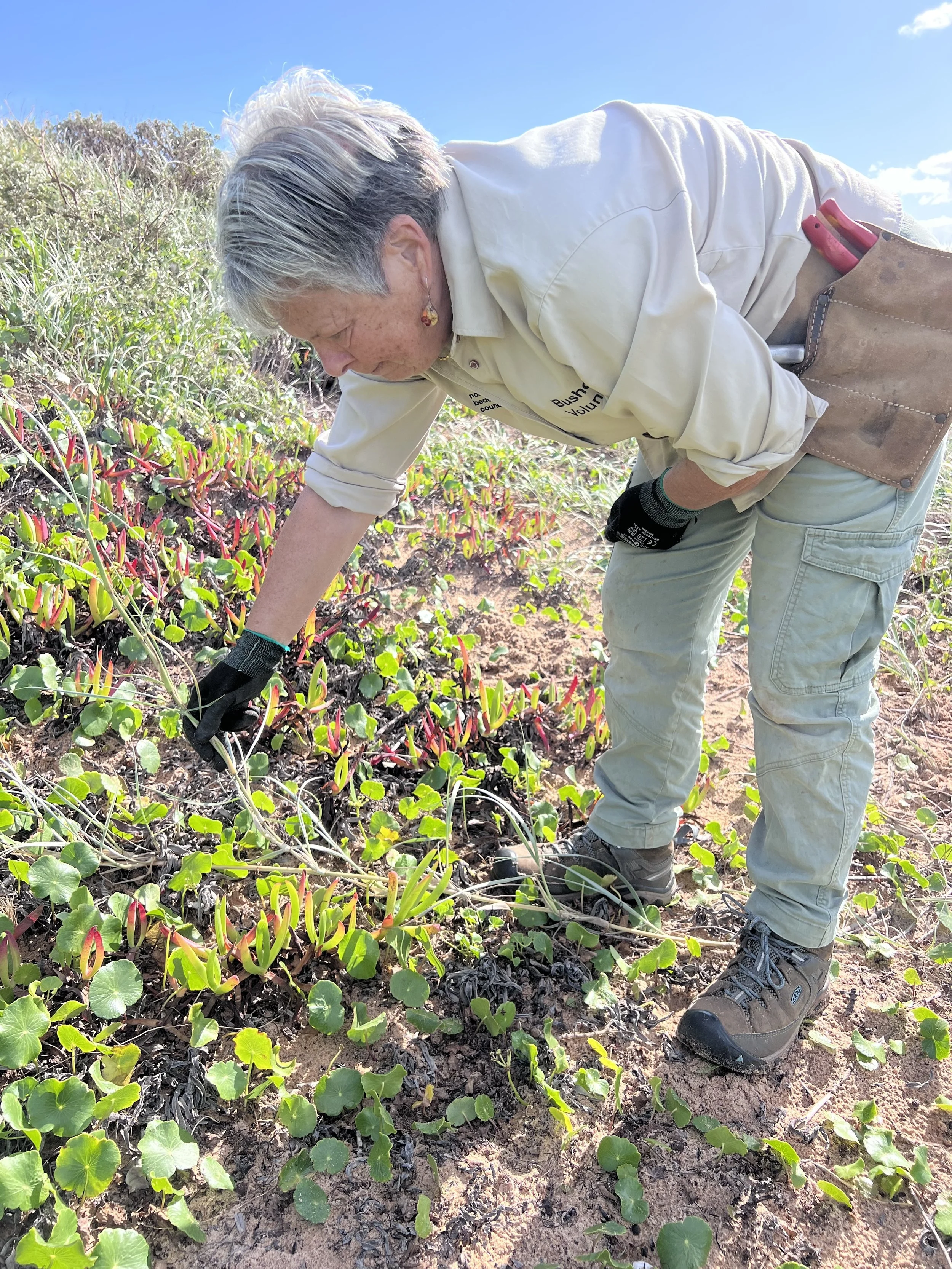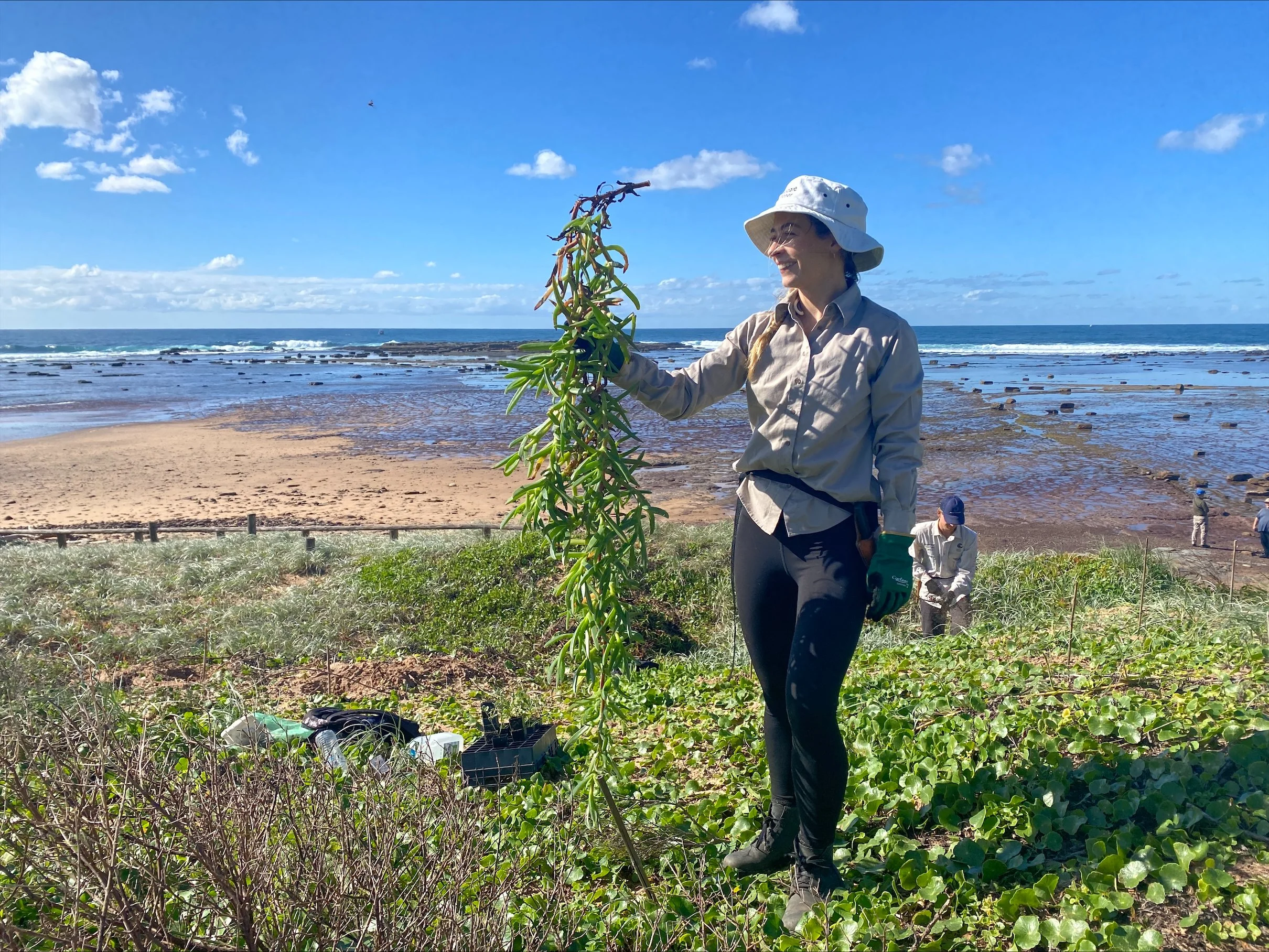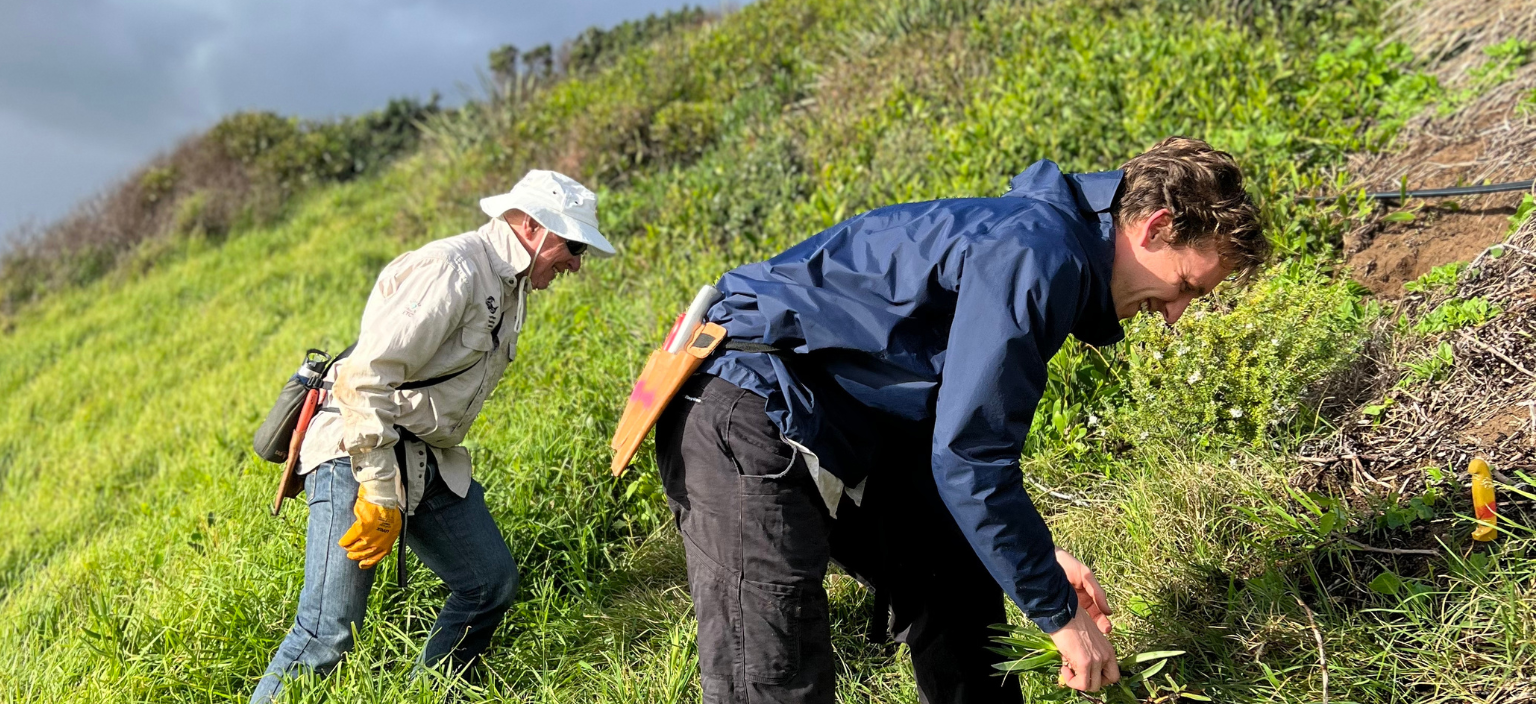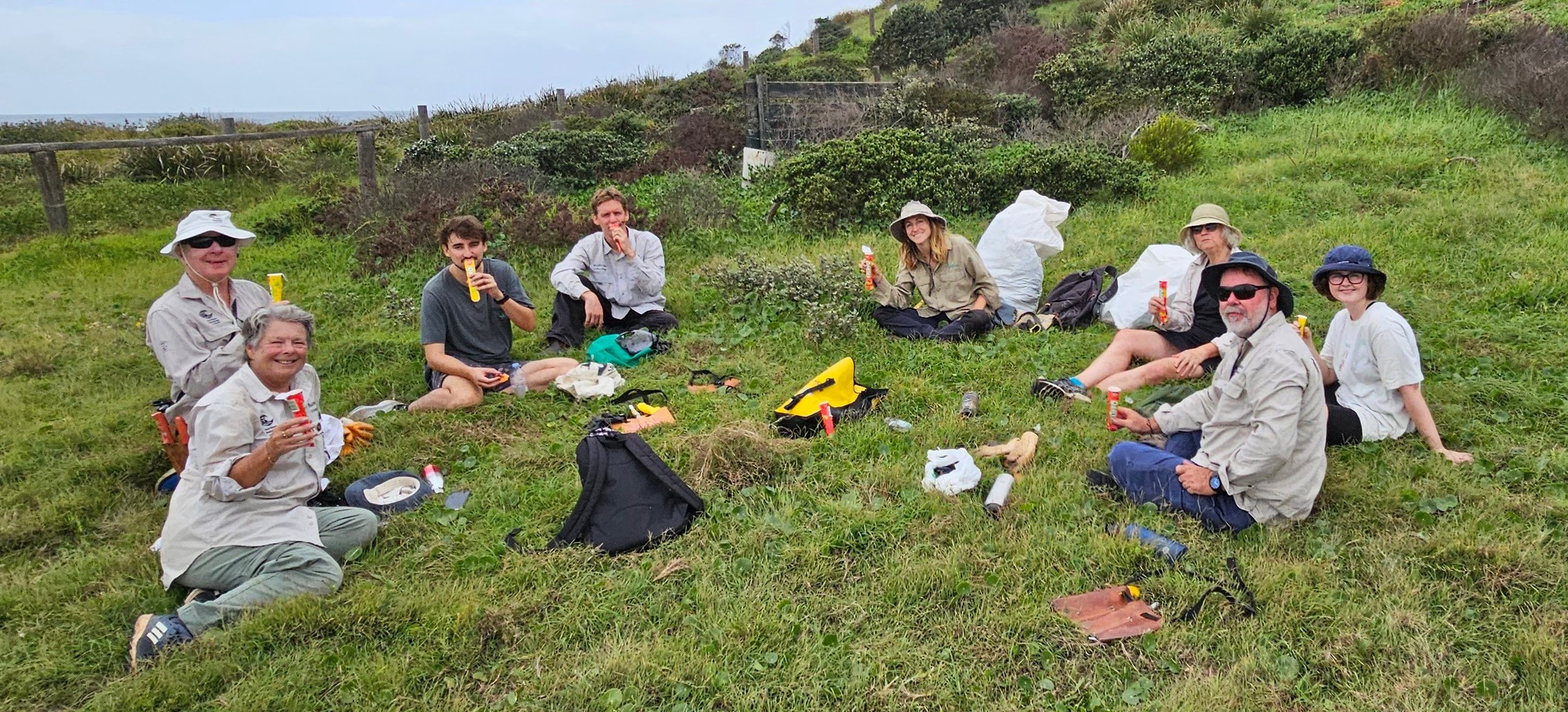
Blog
Beach Stone Curlew Spotted!
A beach stone curlew has been spotted at Long Reef Oct-Nov 2025 by numerous people, including Jim Rothwell who found it on the 12th of November on a small beach on the south side of Long Reef headland at 12.40 pm with rising tide. This bird is rare at Long Reef as it is Critically Endangered (CE) in NSW. Long Reef provides a protected environment for endangered and migratory bird species, which was a major reason this area was designated as a Marine Protected Area. Sightings like the beach stone curlew highlight the importance of protecting this habitat.
Beach Stone Curlew - Photo by Jim
A beach stone curlew also known as a beach thick-knee was first spotted at Long Reef in October 2025 and is currently still being spotted (29 November 2025). It caused quite a stir as everyone thought it was a one off, so there have been many bird spotters and photographers at Long Reef trying to find it.
Jim Rothwell was one of those that encountered the curlew: ‘On 12th November my wife Jennie and I saw a beach stone curlew on a small beach on the south side of Long Reef headland at 12.40 pm with rising tide. This area is a marine sanctuary and meant to be dog free which helps I’m sure.’
He also provided us with an extract from the NSW government website: https://threatenedspecies.bionet.nsw.gov.au/profile?id=10280
‘Description - The Beach Stone-curlew is a large, heavy-set wader (up to 56 cm in body length, and with a wingspan of up to 1.1 m), with a large-headed appearance, emphasised by its massive bill, strong legs and a short tail.
Distribution - In Australia, the Beach Stone-curlew occupies coastlines from about Point Cloates in Western Australia, across northern and north-eastern Australia south to north-eastern NSW, with occasional vagrants to south-eastern NSW and Victoria. In NSW, the species occurs regularly to about the Manning River, but recent records show a breeding pair is known from the Port Stephens area (Dowadee Island and Soldiers Point [mid-north coast]) and more recently the species has been recorded at Whale Beach in Twofold Bay near Eden. These new records extend the known limit of the normal range of the species in Australia to the far south coast of NSW. Surveys in 2000 put the NSW population at a minimum of 13 adult birds. Outside Australia, the species also occurs in south-eastern Asia, from the Malay Peninsula through Indonesia and southern New Guinea, east to the Solomon Islands, Vanuatu and New Caledonia.’
This bird is rare at Long Reef, as it is Near Threatened (NT) globally and Critically Endangered (CE) in NSW. Long Reef provides a protected environment for endangered and migratory bird species, which was a major reason this area was designated as a Marine Protected Area. Sightings like the beach stone curlew highlight the importance of protecting this habitat.
Text by Jim Rothwell and Misima
Reefcare Report: Weeding and Wildlife!
Our fabulous Reef Care crew worked through the light showers, removing bitou, asparagus fern, burr medic, thistles, asparagus fern, oat grass and bromus. The main highlight for the day was the wildlife, with fairy wrens, willy wagtails, 2 x white faced herons, a nankeen kestrel, a BEACH STONE-CURLEW and WHALES! We even saw a magpie kill and eat a ghost crab.
Karina and Jennie removing Burr Medic, Jim in back - Image by Lisa
Despite the inclement weather, 8 of us with our Supervisor Mahi turned up for what happened to be a wonderful wildlife experience day!
Our fabulous Reef Care crew worked through the light showers, and got to enjoy a morning tea with Mahi’s chocolate cake in sun/cloud and being harassed by our resident magpies; they are so used to us they come within 30cm, talking and singing.
Juvenile magpie
Julie at morning tea gave the group an update on how we will continue to remove Bitou which is now getting into difficult terrain, so this will be done with Council and Contractor assistance, where the contractors will do the hard work and Reefcare will do the follow up clearing and planting.
Most of the crew worked on weed removal, Julie and Merrilyn asparagus fern, Gen and Brad cutting back bitou, the rest of us working in a couple of areas at the bottom of the site, removing spent Burr Medic (it was still covered in seeds so worth the work bagging this to reduce the seed bank), thistles, asparagus fern, oat grass and Bromus. Jim and Mahi worked weeding around the contractor plantings just west of the main track.
Removing old Burr Medic that still had seeds
But this highlight for the day was the wildlife, with fairy wrens, willy wagtails, ladybirds, 2 x white faced herons, Nankeen Kestrel and WHALES! Jennie spotted them first, there was a mother and baby which seem to just go around the whale watching boat – they must have had a wonderful viewing, the whales were so close, and another a little further out, slapping it’s tail. On the way back a number of us got to watch a magpie kill and eat a ghost crab – that was certainly something to watch – only a foot away from us.
Superb fairywren and ghost crab - Photos by Misima
The bird photographers were all out as a beach stone-curlew (Esacus magnirostris) had been sighted at Long Reef only two days before, these birds are seriously rare now as there are limited sites for breeding due to human development along the coast. The birds form a nest in sand, laying one egg per season just above the high tide line on the open beach, where it is vulnerable to predation and human disturbance.
We finished the day with several very full weed bags, as some of the Burr Medic can grow to quite a size. Other weeds that were targeted were blackberry nightshade, various thistles and of course – asparagus fern!
Text by Lisa
Reefcare Report: Tackling Burr Medic, Oat grass, Bromus
A sunny day greeted the small team who had stayed behind for the October Long Weekend. Julie worked on clearing asparagus fern at the top, while the rest of the group focused on weeding Burr Medic, oat grass, Bromus along the path and main site area. Morning tea included caramel cake from Mahi, and several full weed bags were collected by the end of the day.
Lovely Site photo: clouds and sea are aligned - Photo by Mahi
A lovely sunny day greeted the few of us, that had not gone away for the October Long Weekend; which meant that we did not have the boots on the ground to plant the Carpobrotus tube stock which we had brought along… always another time.
Julie continued to work up the top on asparagus fern as she has done for many, many months, slowing moving further west as she clears an area. Up the top of the site near where Julie is working a red wattlebird was seen - they like the Banksia, so we don't see them further down Long Reef point and on our grassland site.
Julie working on Asparagus fern - Photo by Mahi
Red Wattlebird - Photo by Mahi
The rest of the team, Mary, Arthur, Mahi and myself did some weeding on our site along the path where there was a great array of weeds; before then saying, let’s get onto our real site area where we worked on Burr Medic as well as oat grass and Bromus. The Burr Medic is not quite as bad as previous years, so hopefully now the targeting of the last dozen years is now starting to pay off.
The Oat grass and bromus this year are also far less numerous than the previous few years, which is unusual for this time of year. Has the weather not been good for these weeds? Has our past few years attention in targeting these weeds managed to reduce the number? Wish I knew the answer – let’s hope it means our past several years’ work targeting this weed has worked.
Below are two holes dug in the dirt which we have now been finding for about a year now, we think these are from bandicoots. - Photos by Mahi
We stopped for morning tea at 10:30am - Mahi brought us a beautiful caramel cake for morning tea and some fruit juice.
Arthur, Mary and Lisa at morning tea, waiting for the caramel cake to arrive!
We finished the day with several very full weed bags, as some of the Burr Medic can grow to quite a size. Other weeds that were targeted were blackberry nightshade, various thistles and of course – asparagus fern.
Text by Lisa
Reefcare Report: Raptors, Planting and Weeding
A lovely sunny day greeted the Reefcare team which included two new volunteers, Maria and Shaan. 12 native Carpobrotus were planted at the top of the N/W slope. While raptors flew overhead, volunteers worked on removing Asparagus fern, Bitou, Gladioli, Burr Medic and Turkey Rhubarb.
Our volunteer team enjoying morning tea - (Shann, Mahi, Denise, Arthur, Mary, Stefanie, Karina, Gen, Brad, Merrilyn, Maria, Misima, Lisa, Paul)
A lovely sunny day greeted the Reefcare team together with Georgia from NBC who introduced the team to Paul – our Supervisor for the day, and Mahi (both from Dragonfly Environmental) who will take over the usual monthly supervision, now that Kathy is on maternity leave. On site, Georgia ran through the Site Plan with Mahi and any other volunteers who wanted to attend.
Brad and Gen worked on the Bitou, whilst Merrilyn scouted the site for Gladioli, Asparagus fern, small Bitou and Burr Medic.
Lisa set up Stefanie, Karina, Misima, Denise and Paul to weed the top n/w slope and then make terraces and plant 12 native Carpobrotus, before heading down the slope where Georgia had the rest of the team weeding on the flat.
Planting Carpobrotus on slope - Misima, Stefanie, Karina, Denise, Paul
Lisa spent some time there with 2 new volunteers, Maria and Shaan pointing out the weeds in this area and what to bag to remove from site and what can be left to rot for mulch.
Mary wanted an area that she is able to dedicate herself to on the flat, so with Arthur, I allocated the n/e dunes which was full of Burr Medic.
When the season is over for this weed, Mary and Arthur can then move to the eastern dunes to maintain the 2 demarcation lines to stop the non-native pigs face getting into the eastern flat and the kikuyu moving south into a really good patch of Kangaroo Grass.
Paul brought us some lovely fresh fruit and a cake for morning tea. After morning tea, Lisa with Stefanie, Karina, Shann, Maria, Misima and Mahi worked back and forth along the main slope removing Asparagus fern, small Bitou and Burr Medic – until we got to the top where Mahi worked on Turkey Rhubarb and the others cleaning up any non-native pigs face from our previous cleared area – which is looking fabulous with a grassy cover, so no erosion issues.
Denise weeding Blackberry nightshade (Solanum nigrum)
It was a great day for bird watching as we saw a white bellied sea eagle, osprey and a nankeen kestrel of which Stefanie got some great video footage.
We also had a police helicopter constantly flying over, looking for the shark around the reef, who had at 9:30am attacked a surfer and Dee Why/Long Reef beach, killing him.
There was very little oat grass and/or Bromus this month which is unusual for this time of year – has the weather not been good for these weeds? Has our past few years attention in targeting these weeds managed to reduce the number? Wish I knew the answer – let’s hope it means our past several years’ work targeting this weed has worked.
Text by Lisa
A Heartfelt Thank You from the Community
The Reefcare team has received a warm message of appreciation from community member, Mona Kalt, for the ongoing bush regeneration efforts at Long Reef Headland.
Our Reefcare team enjoying morning tea
The Reefcare team has received a warm message of appreciation from a community member, Mona Kalt, for the ongoing bush regeneration efforts at Long Reef Headland and along the path to Griffiths Park.
“Hi Bush Regeneration Team,
Thank you for the wonderful planting and care around Long Reef Headland and the path to Griffiths Park. Your great work is much appreciated.
Kind Regards,
Mona Kalt”
This is the first public thank-you we’ve received, and it’s a fantastic reminder of the positive impact our volunteering efforts have on both the environment and community.
Congratulations to everyone involved! Your dedication is making a real difference at Long Reef!
Our Reefcare team having a quick break
🌱 Interested in joining us? Come along to a Reefcare Working Day and be part of our passionate conservation community!
Reefcare Report: Bad Weather
Unfortunately, Reefcare had to be cancelled prior to our working day due to windy and rainy weather – the weather in Sydney over the past few weeks had been awful, so the cancellation was certainly no surprise.
Unfortunately, Reefcare had to be cancelled prior to our working day due to windy and rainy weather – the weather in Sydney over the past few weeks had been awful, so the cancellation was certainly no surprise.
Reefcare Report: More Weeding!
Two new volunteers joined our Reefcare team! We continued weeding invasive pig’s face and removing asparagus fern crowns and berries to prevent further spread. We were joined by magpies, ospreys, welcome swallows and a cool insect.
Volunteers weeding non-native pig’s face
It was a mostly sunny morning this session where we welcomed two new volunteers to the Reefcare team!
While we worked, there were several ospreys flying around and were surrounded by lots of welcome swallows and magpies. We also found a Giant Green Slantface insect that was very hard to spot as it was completely camouflaged as a blade of grass.
Osprey flying at Long Reef
Giant green slantface camouflaged in grass
We mainly concentrated on continuing the weeding of non-native pigsface particularly targeting areas where it was crowding native species. We created a gap between 0.5-1m to allow them to grow without competition and recover.
Arthur and Mary weeding non-native pig’s face – Photo by Stefanie
At the top of the hill two volunteers worked on continuing to prevent asparagus fern spread. We removed some of the smaller crowns but mainly focused on removing the berries to prevent new plants from establishing in other areas of the site via birds. Misima said: “You will not believe the amount of berries that we collected and bagged.”
Another pair worked steadily across the slope, pulling out smaller asparagus ferns wherever they found them, as well as any other invasive weeds that had popped up.
Volunteers removing invasive weeds from grass slope – Photo by Stefanie
Text by Misima
Reefcare Report: Weed removal and Wildlife
Volunteers spent June’s working bee tackling invasive pig’s face and asparagus fern while planting new natives. Along the way, they spotted a rare snail, a bandicoot burrow and new invasive plant called African fireweed.
Beautiful shot of Long Reef rock platform and grass slopes
The June working bee's primary focus was pulling out non-native pig’s face and planting a tray of 30 plants around the western area of the site.
The weather was perfect, we were welcomed by lots of wildlife. We have found evidence of a bandicoot as there is a burrow along the slope. We found a fuller’s rose weevil while weeding pig’s face. We also found a new sapling of banksia under a tea tree and unfortunately found a new weed has been introduced to the site, called the African fireweed. Two Ospreys flew over who had caught a fish each and magpies foraged nearby hoping to catch worms in the unearthed soil.
Self Seeded Banksia Found under a Tea Tree – Photo by Stefanie
Australian Magpie standing on dead pig’s-face - Photo by Stefanie
We pulled out a large amount of pig’s face on the slope. You can tell it is non-native by the long green leaves which are like a carpet over smaller native plants.
Karina weeding Pigs Face – Photo by Stefanie
The Maroubra snail was first discovered on site two years ago, it is very rare and found again today, it has a brown shell.
Maroubra Snail on leaf – Photo by Brad
There was a fire ant nest nearby where we were planting meanwhile placing water crystals in the soil.
Julie did a bag of asparagus crowns and either dug or poisoned them: “I continued working in the area below the Whale Sculpture, focusing on the removal of Asparagus Fern. Where the plants were easily accessible, I cut around the crown with a jab saw, and cut off stems, roots and the globular water nodules.”
The first photo shows a trimmed crown about to be cut out. It is only the crown that needs to be removed. The second photo shows trimmed crowns on the bag.
“Where the plant is growing under native bush or other obstacle, I join stems into a ' ponytail', trim the top, scrape the stems and spray with glyphosate.” The third photo shows some 'ponytails' tinged blue with glyphosate. “These will be checked next time I'm on site. I'm confident of asparagus death!”
Text by Stephanie
Reefcare Report: A Lucky Break in the Weather 🌿🌞
A sunny break in the rain gave our Reefcare volunteers the perfect window to get stuck into weeding, planting, and caring for the dunes at Long Reef. Another great morning of teamwork and restoration in action.
Early start, big impact. Our amazing Reefcare crew gearing up in the carpark before heading out to protect and restore Long Reef’s dunes and bushland.
After a week of rain, we were lucky to have a beautiful, sunny day with barely any wind — perfect conditions for our working bee. Denise, Misima, Kathy, and Lisa spent the morning in the eastern dune area, with Alex joining after doing some follow-up on Turkey Rhubarb and Asparagus Fern. We continued removing non-native Pigface from the small bowl-like area we began restoring three months ago and planted 20 tube stock in the space.
Volunteers got their hands dirty removing Pigface, tackling Asparagus Fern, and planting native tube stock to help restore the dunes.
Despite the spread of Hydrocotyle bonariensis due to recent rains, we’re confident our new plantings will thrive and outcompete, as it’s the growing season.
Julie focused her efforts at the top of the site, tirelessly working to remove Asparagus Fern — crowning, scraping, and poisoning where needed — and also cleared more Pigface from that area.
Merrilyn was on the move across the site on her own Asparagus Fern mission. It’s everywhere — about one every step or two — but thanks to her vigilance, we’re catching many of them early while they’re still small.
Gen and Brad worked down in the gully, cutting back Bitou where full removal isn’t possible due to the fragile cliffs, and continued clearing Pigface from our planting zones.
We were joined at morning tea by Michael Kneipp from Northern Beaches Council, who visited to discuss two key areas of concern. He was pleased with the progress in the eastern dunes but shared some reservations about sections in the far western part of the site. Lisa and Kathy assured him that Reefcare will take these concerns into account in planning and prioritising future work, particularly around the western gully.
Refuel and reconnect. Our Reefcare team pausing for morning tea after a solid few hours of conservation care at Long Reef.
A big thank you to everyone who came out — your dedication is making a real difference. 💚
Reefcare Day Report: Bushcare wildlife encounters
When the five of us arrived on site at the western slope with 20 plants and a goal to remove more of the non-native pigs face we were serenaded by a delightful singing juvenile magpie who seemed to enjoy having us all around her …
When our team of five arrived at the western slope armed with 20 plants and a mission to clear out more non-native pigs face, we were greeted by the melodious song of a juvenile magpie. Several other juveniles joined in, a heartening sight given the declining numbers of magpies along the east coast.
Magpies, known for their intelligence and complex social behaviors, often delight with their vocal prowess, echoing through the bushland as we began our conservation efforts.
Des and Alex immediately began tackling a patch of Bidens Pilosa, followed by the discovery of Turkey Rhubarb further east—recent invaders from the dunes behind Long Reef.
Meanwhile, Denise captured a colorful hairy caterpillar on camera, noting its vibrant hues and recognising it as a species known for its camouflage ability against local flora.
Lisa uncovered a puffball fungus previously unseen by others. She squeezed it gently, causing dust-like spores to spurt out—a fascinating sight captured on film by Denise, adding to our documentation of local biodiversity.
Julie focused on removing Asparagus Fern atop the slope, hoping to coordinate efforts with NBC's contractor to combat this persistent weed.
As we worked westward, pulling up non-native pigs face, Alex made a significant find: a large amount of Turkey Rhubarb entwined with Acacia roots, a species known for its rapid spread and ecological impact in coastal areas.
Lisa and Alex collaborated to collect seeds and bulbs before rain interrupted briefly at 10 am. Undeterred, we pressed on, uncovering unexpected grass beneath the pigs face, potentially native couch. Further back, Kikuyu grass posed a future challenge, noted for follow-up with Jock from NBC.
Morning tea on the slope provided a scenic break, although whale sightings were absent.
However, we were visited by a charming native rat with light grey fur, a species likely native to the area and indicative of the healthy biodiversity our conservation efforts support.
Kathy's subsequent discovery of signs suggesting native marsupials in the vicinity added to the excitement, highlighting the potential habitat richness of Long Reef.
Later, Lisa's find of live snails sparked intrigue, prompting detailed photos for identification, a step towards better understanding the diverse ecosystem thriving amidst our restoration efforts.
At day's end, Alex delighted a juvenile magpie with a worm, revealing their clever and curious nature.
Despite Kathy's encounter with a tick, treated promptly with Lyclear, the day concluded on a high note with remarkable wildlife encounters. Reflecting on our efforts, the transformation of this site—once dominated by invasive Bitou Bush—now supports thriving wildlife, a testament to Reefcare's impact.
Denise's ongoing work to update Reefcare's website promises to showcase our discoveries at Long Reef, underscoring the importance of our conservation efforts.


